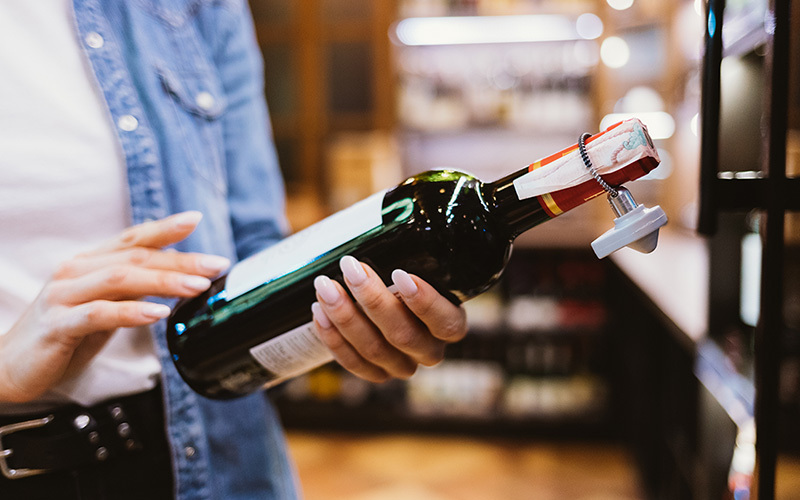
Stay Informed
Get the latest news, trends, and industry insights.
In the world of wine, a captivating label is often the first encounter a consumer has with a bottle. Consequently, crafting a wine label that not only stands out on the shelf but also tells a story is of the utmost importance to the success of a wine brand. So let’s delve into the realm of wine label design. We’ll explore the nuances of creating a label that goes beyond just being visually appealing — one that captivates consumers and generates PR-worthy buzz to boost sales to the next level. Whether you’re drawn to funky, artsy natural wine labels or prefer the timeless elegance of classic wine labels, there are reasons each label may entice individual tastes. Read on to discover the key elements that make a wine label irresistible to your target audience.
Why Your Wine Label Is So Important
Whether we like it or not, the average consumer shopping for wine at the supermarket or local wine shop makes their purchase decision based on aesthetic cues, i.e., the wine label.
The design of a wine label essentially serves as the visual ambassador of the wine, communicating vital information while capturing the essence of the brand. A wine’s label is generally the first point of contact with consumers and has the power to influence their purchase decisions. Beyond its more practical points, such as conveying grape variety, region, and alcohol content, a wine label can be an excellent storytelling tool. It offers the winery a chance to encapsulate the winery's personality and heritage, as well as the unique qualities of the wine itself.
Visually appealing label designs can evoke emotions or spark curiosity amongst consumers, creating a memorable connection with the wine brand. This is more significant than ever in today’s overcrowded market with seemingly endless options for consumers to consider.
In a market flooded with choices, a distinctive and aesthetically pleasing wine label becomes a crucial differentiator. Ultimately, a well-designed wine label can be a key element in a winery’s ability to establish brand identity and attract the attention of its target audience.
What To Consider When Designing a Wine Label
When venturing into the intricate process of designing a wine label, there are a handful of critical considerations to make to ensure your efforts are worthwhile. First, begin the process with a clear understanding of your winery’s brand identity and your target audience. Knowing your identity and values is the cornerstone of crafting a label that authentically reflects your brand.
Looking to grow your wine brand? Our proven wine branding strategies can help. Learn more
Wine Label Design Elements
Next, determine the actual design elements of the wine label, including color selection, typography, imagery, label material, style, and production. Each plays a vital role in conveying your brand identity and values to the consumer. To illustrate this, consider the colorful, often artsy labels of natural wines vs. the classic wine labels of prestigious domaines in Burgundy.
If you had to venture a guess, which of these bottles is more expensive? Which bottle do you think would appeal to an indie-music-loving, thirty-something who shops organic at the Sunday farmers market or hits the skatepark on the weekend? And which would appeal to a middle-aged wine collector looking to fill a space in their wine cellar or impress their friends at a Saturday evening dinner party?
Obviously, these examples are a bit skewed, but they get the point across. The bottle on the left is a skin-contact natural wine that retails for $35. It’s a funky blend of organic Gewurztraminer and Zinfandel from two regions in California. The wine on the right retails for upwards of $100 and is from a renowned appellation and prestigious producer in Burgundy.
Additionally, this example illustrates how certain creative features of wine labels, like fancy fonts, embossed labels, or gold foil, can make a wine look more expensive, as evidenced in the classic label design of the Nuits-Saint-George. Conversely, bright colors or colorful graphic designs can make the wine more accessible to different audiences. Conveying price through design is an important piece of a winery’s marketing strategy, as it influences the consumer’s perceived price of the bottle.
Remember, wine labels offer limited space to communicate your brand messaging and the unique selling point of the wine. So, each design element should be carefully considered with the impact on the end consumer in mind. Ultimately, a strategically designed wine label will help make your wine brand more attractive to distributors, too.
What Must Be Included on a Wine Label
Since wine is an alcoholic beverage and, therefore, highly regulated, wineries are required to include certain details on a wine label. These requirements vary by country, but wine labeling requirements in the United States can be found on the TTB website. Here are a few items that must be included on a wine label:
- Alcohol Content
- Color Ingredient Disclosures (if applicable)
- Country of Origin (imports only)
- Importer
- Health Warning Statement
- Name and Address of Winery
- Net Contents
- Sulfite Declaration
Plus, a winery with certifications in sustainability or organic, biodynamic, or regenerative methods should definitely include such certification on their wine labels. These are huge selling points for younger generations and those who make their purchasing decisions based on what’s best for their health and the planet.
Although it’s not yet required in the United States, the European Union issued a new law in 2023 mandating “that wine labels include a full list of ingredients associated with allergies and intolerances, such as sulfites and gluten.” This will surely have a ripple effect throughout the wider wine world, impacting label requirements in years to come.
How To Level Up Your Wine Label and Make It More PR-Worthy
Incorporating QR codes and augmented reality (AR) into wine labels is a great way for wineries to strategically enhance their marketing. By integrating QR codes, wineries provide consumers with a direct, interactive link between the physical bottle and digital content. Customers simply scan the code using their smartphones to access information about the winery, get details about the specific wine, engage in multimedia content related to a specific campaign, or connect with the wine brand on social media.
Augmented reality takes this a step further by immersing consumers in a virtual experience related to the wine. Wineries can use AR to showcase vineyards, winemaking processes, or suggested food pairings, creating a more memorable and personalized experience. Alternatively, wineries can take notes from brands like Chronic Cellars and 19 Crimes, which leveraged AR as an opportunity for further brand storytelling. This innovative approach can add a tech-savvy edge to the traditional wine label that the media may find newsworthy. It also establishes a direct and dynamic connection with consumers, fostering brand loyalty and differentiation in a competitive market.
3 Top Wine Label Design Examples
Here are three examples of wine label designs recognized for their ability to differentiate their respective brands and build a loyal customer base.
Château Mouton Rothschild
Château Mouton Rothschild is a first growth château in Bordeaux located in Pauillac. There are only five first growths, the highest classification of Bordeaux wines, in the region. These chateaux produce wines from the finest terroirs with the most exceptional winemakers. Situated in the Medoc on the left Bordeaux bank, Cháteau Mouton Rothschild wines command anywhere from $1,000 to $15,000 per bottle or more at auction.
In honor of such a prestigious and highly sought-after wine, Château Mouton Rothschild commissions a famous artist to design a new label for each vintage. Not only does this capture the attention of art lovers, but it makes each bottle even more valuable to collectors seeking to get their hands on the one-of-a-kind artwork adorning the newest vintage. Talk about creating a PR-worthy label! The Chateau has had labels designed by Picasso, Andy Warhol, Miro, and Salvador Dali as well. Chiharu Shiota designed the label artwork for the latest release of the 2021 vintage.
Veuve Clicquot
The Veuve Clicquot wine label has achieved iconic status for several reasons. First, the label’s distinctive yellow-orange color stands out prominently, making it easily recognizable on store shelves and in social settings. This bold choice of color has become synonymous with the brand itself. Additionally, the label features the iconic Veuve Clicquot logo, which pays homage to Madame Clicquot, the widow who took over the Champagne house in the early 19th century. The combination of historical significance, strong visual identity, and consistent branding has contributed to the enduring iconic status of the Veuve Clicquot wine label. It not only reflects the quality and tradition associated with the brand but also serves as a symbol of luxury and excellence in the world of Champagne.
The Prisoner
Dave Phinney’s The Prisoner was one of the most commercially successful and aesthetically unconventional wines of the last two decades in America. This rule-bending red blend is made with an unlikely mix of Zinfandel, Cabernet Sauvignon, Petite Sirah, Syrah, and Charbono. As a pioneer in this style, The Prisoner needed an unorthodox label to match. Phinney landed on a Goya etching of a man in chains and chose to only include the name of the wine (and not the name of the producer) on the label. It remains a highly successful wine thanks to its unconventional identity.
Ready To Upgrade Your Wine Label?
Crafting PR-worthy wine labels involves a delicate blend of creativity, storytelling, and strategic branding. From featuring captivating visuals to incorporating unique elements like QR codes and augmented reality, the key is to create labels that showcase the essence of the wine and tell a compelling story that resonates with consumers. By leveraging design to evoke emotions and communicate the brand's identity, wineries can elevate their presence in the market and capture the attention of enthusiasts and newcomers alike.
Want to know more about what it takes to design a wine label that’s impossible to forget?
API key not valid. Please pass a valid API key.You might also like:
Stay Informed




